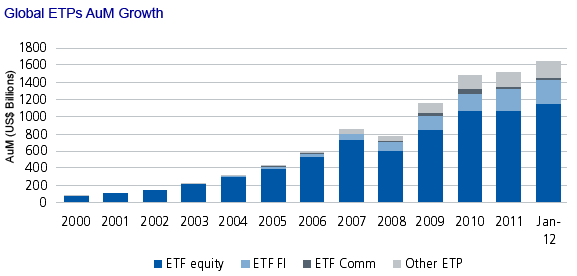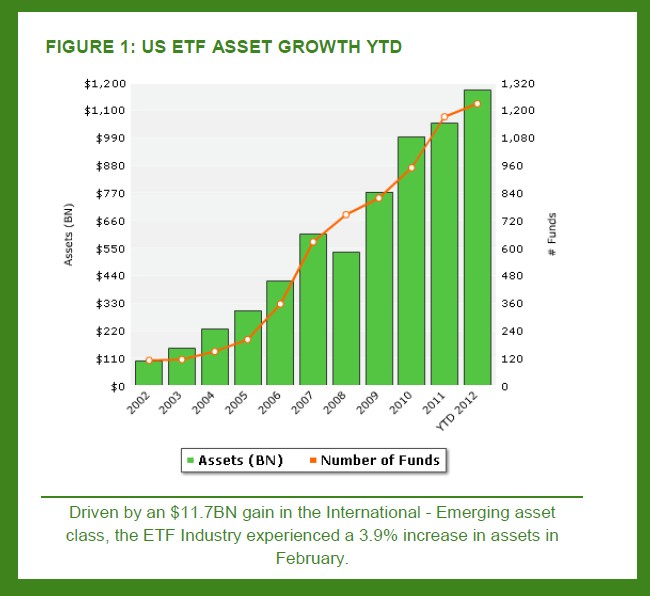Of Exchange Traded Funds
Post on: 12 Апрель, 2015 No Comment

Confusion apart, the fact remains, that most people do not like the management and the investment policies and the high operating expenses associated with the actively managed mutual funds. The performance of mutual funds also does not offer the level of transparency that the investors would expect.
Another problem with the mutual funds is that the funds of the investors just lie in the portfolio for years. Though this may be a good investment policy as it brings in the benefits of long term investment, yet the investors cannot get the advantages of short term movements in the market.
For example, when Hurricane Katrina occurred in 2005, there was an upturn in crude oil prices. If the investors wanted to take advantage of this upsurge in crude oil prices, they would have to wait until the end of the business day when the net asset value ?NAV- is calculated. The investor would again have to wait till the next day to buy the shares of the mutual fund with the oil company holdings and the value of the share would remain unchanged till it was again determined only at the end of the day. By this time the value could fall again before the investor was able to sell his shares.
It may be noted that the value of the oil stock might have risen during the trading period in course of the day, but the investor could not take the advantage of the price rise and sell his shares. Moreover the investor would also have to pay penalties and possibly the sales commissions if he sold his shares. Mutual funds do not provide any investment tools for those who wish to invest on short term price movements.
Exchange Traded Funds or ETFs were, therefore, devised to remedy the problems that are associated with the mutual funds. ETFs are index funds as they are designed to track the major indexes such as the S&P 500 or NASDAQ.
ETFs may not be actively managed, but their returns are in-line with the benchmarks that they are designed to mirror. ETFs also mirror other indexes and offer a number of significant benefits to the investors. So if some tech company promises a good earning, with an ETF that tracked the NASDAQ, an investor can buy shares early on and then sell them later for a profit, because ETFs trade like stocks.
ETFs trade like stocks. Investors have to pay commissions for their trades in the same way they have to do for stocks. But even these commissions can be reduced considerably by finding brokerages that charge very low or flat commissions.
ETFs give the investors a great amount of flexibility along with the added benefit of reduced risks due to diversification at minimal expense. Asset allocation forms an important part of sound investment strategy. It is against all cannons of sound investment to put all the eggs in one basket. This is the reason why investment experts advise the investors to split the portfolio among a variety of asset classes.
Another big reason for the popularity of the ETFs is that they are much cheaper than the actively managed mutual funds. Most investors love to invest in ETFs because they are not actively managed and their low expense ratios allow the investors to invest more money in them. An average expense ratio for an ETF is between 0.1-0.7 percent.
A great complaint about mutual funds is against their high management operating fees and commissions that are taken out even before any shares are purchased. These deductions may lower the turnover and also reduce the amount of capital actually used to invest.
ETFs cover all major indexes, asset classes that any niche investor can imagine and aspire to invest in. There are ETFs that are comprised exclusively of specialty industries in the tech and energy sectors besides the commodities such as gold and oil. Investors can add real estate investments to their portfolio and can thus create a portfolio consisting of diversified investments quickly and simply by using ETFs.
Of Exchange Traded Funds
There are three legal structures of ETFs: Open-end mutual fund (the difference between the ETF structure and an open-end mutual fund is the ETF is exchange traded, whereas the traditional mutual fund is purchased and redeemed by the fund itself), Unit investment trust and Grantor trust.
The open-end mutual fund structure has a diversification requirement, mandated by the Investment Company Act of 1940, which limit how it mimics some smaller or specialized indices and could result in a tracking error. The other principal difference for the investor is that other than the open-end mutual fund, dividends must be paid out in cash to investors. These structural differences aren’t significant for most investors. The more important question is whether it’s the right one for you in terms of what index it’s designed to follow.
The index and dividend payout requirements are disclosed in its prospectus and most Exchange Traded Funds also have websites where you can find this information. Tracking error is the difference between the return on the index the EFT is designed to follow and the actual return on the index.
An EFT which holds all 500 stocks in the S&P 500, in the same weighting as the S&P 500, should have exactly the same return as that index, less fund expenses. That’s an easy one. ETFs that are created to track, say, the biotech stock index will have different interpretations of that index.
A biotech could weight all stocks equally, weight by market cap, hold big cap or small cap bio stocks, and so on. As a result, performance will vary with the success of its strategy. A good illustration of this is in Biotech ETFs: It Pays to Shop Around, in the October 15th BusinessWeek. The five funds BusineesWeek highlights had year-to-date return ranging from -3.7% to 27.3%.
ETFs are required to disclose their holdings every day, unlike mutual funds which only have to disclose once a quarter. However, this should not be a big deal because we’re dealing with index funds and the components of indexes should not change very often.
There are two aspects of ETF liquidity for investors to consider: the ETF and its index’s securities. Since ETFs trade like stocks, they can be traded all day long. Open-end mutual funds can be purchased or redeemed only once daily, after the market closes. You have to put your order in prior to 4PM (while the stock market is still open) or wait until the next day. The liquidity of the EFT-the frequency with which it trades and the depth of the market-is similar to a stock and parallels the size of the EFT.

But ETFs also have a very unique feature, they can be expanded or contracted depending upon demand, see Share Creation/Redemption, which provides them with even greater liquidity. And, ETFs can be more liquid than the individual shares they hold, thus, providing investors with greater liquidity. This is especially true for an ETF that holds small cap stocks, which are thinly traded, or bonds other than US Treasuries, which trade infrequently.
Authorized Participants, think big banks who act as market makers or specialists on an exchange, trade market baskets of the underlying index’s securities to the EFT in exchange for new ETF shares, when the demand for ETF shares increases. The Authorized Participants then sell these newly created ETF shares on the open market. The process is reversed if there are more sellers than buyers of the ETF.
The purpose of this feature is to keep the ETF’s market price as close to its net asset value as possible. (The risk exists that the Authorized Participants would not, or would not be able to, perform this function during a market crisis. The result of this could be an ETF which trades away from its net asset value.)
The price at which the ETF trades is based upon supply and demand. Unlike the share of an open-end mutual fund which is purchased or redeemed at its net asset value (NAV), the price of an ETF share may trade above or below its NAV. By way of comparison, closed-end mutual funds often trade away from their NAV for extended periods of time.
Unfortunately, many closed-end mutual funds trade significantly below their NAVs. The Authorized Participants provide vital role, through share creation and redemption, in keeping the price of the ETF close to its NAV.
The structure of Exchange Traded Funds give the investor a tax advantage over mutual funds. Open-end mutual funds, even index funds, must sell shares of the stock they own to raise cash when redemptions exceed purchases. These sales can result in taxable gains and losses which are passed along to the investor. Thus, you could have a taxable gain on the fund you own, even though you didn’t sell it. The share creation and redemption process shifts this liability to the Authorized Participant.
If the Authorized Participant trades shares to the EFT, it is responsible for the taxes on any gains if it sells the securities it received from the ETF. Of course, the investor is liable for any taxes upon selling an ETF or mutual fund.
ETFs have lower fund expenses than index mutual funds, although the difference is usually only a few basis points. (Don’t be misled by advertisements which compare their expenses to actively managed open-end mutual funds.) Theoretically, the expenses for an ETF or mutual fund structured to track the same index, assuming they’re roughly the same size fund, should be the same.
Since ETFs are traded like stocks, the commission charged to buy or sell is similar to the commission on a stock trade. Index funds are no-load, and are commission free, although some charge a back-end fee if you don’t hold it for a certain period of time. The second cost to consider is the bid/ask spread. Even stock and ETF has one, although in most cases they’re very small, i.e. a few cents, unless the ETF is very illiquid. Transaction costs-none vs. some-favor no-load mutual funds over ETFs but the cost differential is slight
What are the uses and advantages of ETFs? Come back next week and I’ll tell you.














